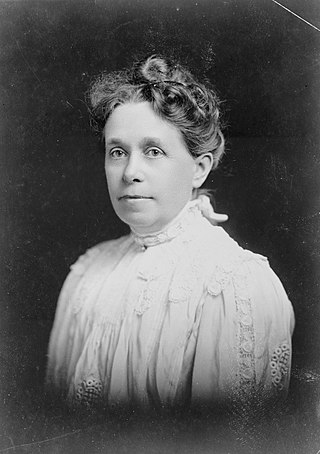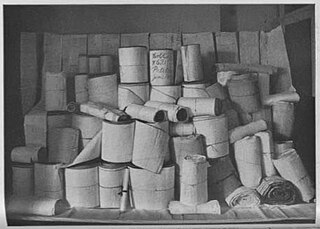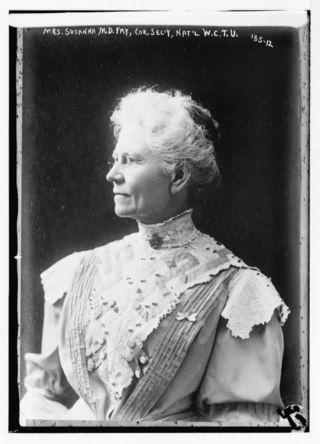The Woman's Christian Temperance Union (WCTU) is an international temperance organization. It was among the first organizations of women devoted to social reform with a program that "linked the religious and the secular through concerted and far-reaching reform strategies based on applied Christianity." It plays an influential role in the temperance movement. Originating among women in the United States Prohibition movement, the organization supported the 18th Amendment and was also influential in social reform issues that came to prominence in the progressive era.

Frances Elizabeth Caroline Willard was an American educator, temperance reformer, and women's suffragist. Willard became the national president of Woman's Christian Temperance Union (WCTU) in 1879 and remained president until her death in 1898. Her influence continued in the next decades, as the Eighteenth and Nineteenth Amendments to the United States Constitution were adopted. Willard developed the slogan "Do Everything" for the WCTU and encouraged members to engage in a broad array of social reforms by lobbying, petitioning, preaching, publishing, and education. During her lifetime, Willard succeeded in raising the age of consent in many states as well as passing labor reforms including the eight-hour work day. Her vision also encompassed prison reform, scientific temperance instruction, Christian socialism, and the global expansion of women's rights.

Marie Caroline Brehm was an American prohibitionist, suffragist, and politician. The Head of the suffrage department for the Woman's Christian Temperance Union (WCTU), she was a key figure in the Prohibition Party and Presbyterian Church, active in both local and national politics, and an advocate of reform laws. Twice she was appointed by the President to represent the United States at the World's Anti-Alcoholic Congress in Europe. Additionally, she was the first woman to run for the Vice President of the United States after the 19th amendment granted women the right to vote.

Lillian M. N. Stevens (1843–1914) was an American temperance worker and social reformer, born at Dover, Maine. She helped launch the Maine chapter of the Woman's Christian Temperance Union (W.C.T.U.), served as its president, and was elected president of the National W.C.T.U. after the death of Frances Willard. Stevens also served as Editor-in-chief of the W.C.T.U.'s organ, The Union Signal.

Margaret Bright Lucas was a British temperance activist and suffragist. She served as president of the British Women's Temperance Association (BWTA), the World's Woman's Christian Temperance Union (WCTU), and the Bloomsbury branch of the Women's Liberal Association.

Anna Adams Gordon (1853–1931) was an American social reformer, songwriter, and, as national president of the Woman's Christian Temperance Union when the Eighteenth Amendment was adopted, a major figure in the Temperance movement.

Mary Greenleaf Leavitt was an educator and successful orator who became the first round-the-world missionary for the Woman's Christian Temperance Union (WCTU). Setting out on virtually non-stop worldwide tours over a decade, she "went to all continents save Antarctica," where she crusaded against alcohol and its evils including domestic violence; and advocated for women's suffrage and other equal rights such as higher education for women. In 1891 she became the honorary life president of the World's WCTU.

Sarepta Myrenda Irish Henry was an American evangelist, temperance reformer, poet and author. She also wrote under the pen name Dina Linwood.

Emily Clark Huntington Miller was an American author, editor, poet, and educator who co-founded St. Nicholas Magazine, a publication for children. Earlier in her career, she served as the Assistant Editor of The Little Corporal, a children's magazine and Associate Editor of the Ladies' Home Journal. Miller and Jennie Fowler Willing were involved with organizing a convention in Cleveland in 1874, at which the National Woman's Christian Temperance Union was formed. In September 1891, Miller was appointed Dean of Women at Northwestern University in Illinois.
The Woman's Temperance Publishing Association (WTPA) was a non-commercial publisher of temperance literature. Established in 1879 in Indianapolis, Indiana during the national convention of the Woman's Christian Temperance Union (WCTU), it was a concept of Matilda Carse, an Irish-born American businesswoman, social reformer and leader of the temperance movement.

The Frances Willard Schoolhouse is a one-room schoolhouse built in 1853 in Janesville, Wisconsin. Prominent women's suffragist and social reformer Frances Willard studied and taught there. In 1977 the school was added to the National Register of Historic Places.

The Woman's Christian Temperance Union Administration Building is a historic building in Evanston, Illinois, United States. It has served as the publishing house and national headquarters of the Woman's Christian Temperance Union since its construction in 1910. The organization had an important role in the national discussion on prohibition and women's suffrage.

Esther Pugh was an American temperance reformer of the long nineteenth century. She served as Treasurer of the National Woman's Christian Temperance Union (WCTU), a Trustee of Earlham College, as well as editor and publisher of the monthly temperance journal, Our Union.

Mary Allen West was an American journalist, editor, educator, philanthropist, superintendent of schools, and temperance worker. A teacher in her early career, she served as superintendent of schools in Knox County, Illinois, being one of the first women to fill such a position in Illinois. An active supporter of the temperance movement, West served as president of the Illinois Woman's Christian Temperance Union (WCTU), and editor of the national paper, Union Signal. Her other roles within the WCTU included superintendent of the Training School for Temperance Workers, Illinois State Superintendent of Temperance in Schools of Higher Education, as well as Stockholder, Director, and Secretary of the Woman's Publication Association. She was the first president of the Illinois Woman's Press Association, member of the Chicago Woman's Club, director of the Protective Agency for Women and Children. West was the author of Childhood: Its Care and Culture (1887). She died in Japan, in 1892, while training temperance workers in organization and promotion reform efforts.

Jennie Fowler Willing was a Canadian-born American educator, author, preacher, social reformer, and suffragist. She married a lawyer and Methodist pastor at age 19. In 1873, she and her husband became professors at Illinois Wesleyan University. In addition to teaching, she was a leader in the temperance movement. Willing came to notice when she joined the Illinois Woman's State Temperance Union, serving as its leader for some years. She and Emily Huntington Miller were involved with creating and presiding over the First Woman's National Temperance Convention of 1874 in Cleveland where the National Woman's Christian Temperance Union was formed. She served as the editor of the national organization's journal for a period. In 1895, she created the New York Evangelistic Training School. Willing wrote several books including From Fifteen to Twenty-five: A Book for Young Men and serials for newspapers.

Caroline Brown Buell was an American activist who lectured and wrote on behalf of temperance and suffrage. She served as the assistant recording secretary (1878–80), corresponding secretary (1880–93), and a member of the Our Union publication committee (1876–83) of the National Woman's Christian Temperance Union (WCTU); as well as the president (1904) and corresponding secretary (1875–86) of the Connecticut WCTU. She also originated the plan of the Loyal Temperance Legion, the children's society of the WCTU. Buell wrote extensively for temperance publications, and other papers and magazines. She made her home in East Hampton, Connecticut.

The Polyglot Petition for Home Protection was the first world-wide proclamation against the manufacturing and international trade in liquor and drugs as well as the prohibition of legalised vice. It served as a first major campaign to raise public awareness of the need for international agreements on controls for opium and its derivatives.

The Union Signal is a defunct American newspaper. It was the organ of the National Woman's Christian Temperance Union (N.W.C.T.U.), at one time, the largest women's organization in the United States. Established in 1874 aa The Woman's Temperance Union, it was renamed in 1877 as Our Union. When Our Union merged with another temperance paper, The Signal, in 1883, the organ's name was changed to The Union Signal. Published in Chicago, Illinois, it focused on the woman's temperance movement in the U.S. Initially, a weekly 16-page illustrated newspaper, it shifted location and publishing schedule before it ceased publication in 2016. The last edition of the N.W.C.T.U.'s quarterly journal, titled The Union Signal, was published in 2015, the main focus of which was current research and information on drugs.

Susanna M. D. Fry was an American educator and temperance worker. Her teaching career began in the primary department of the village school, but her superior ability as a teacher led her swiftly into positions of greater responsibility. Fry was a professor who held the chair of English literature at Illinois Wesleyan University, Bloomington, Illinois and at the University of Minnesota. She served as president of the Minnesota Woman's Christian Temperance Union (W.C.T.U.), and managing editor of The Union Signal, the organ of the National W.C.T.U. During her career as a professor and as an official of the W.C.T.U., Fry was a frequent speaker in Prohibition campaigns and at temperance conventions. Fry was the only woman chosen from the Methodist church to speak before the Parliament of the World's Religions, 1893.

Lucy Wood Butler was a 19th-century American pioneer temperance leader. She was the first president of the Woman's Christian Temperance Union (W.C.T.U.) of New York. Butler's financial means enabled her to give her time to charitable works.





















